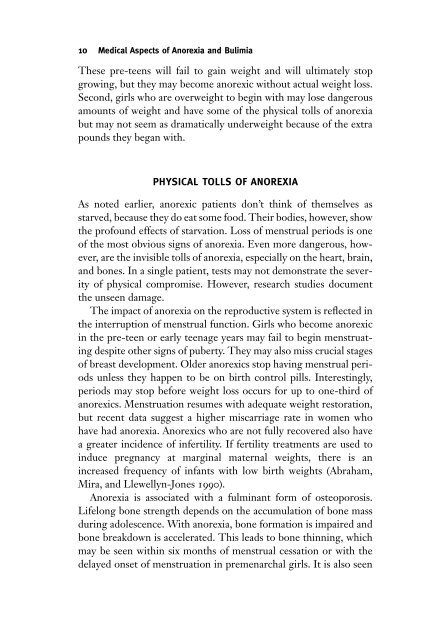Eating Disorders - fieldi
Eating Disorders - fieldi
Eating Disorders - fieldi
You also want an ePaper? Increase the reach of your titles
YUMPU automatically turns print PDFs into web optimized ePapers that Google loves.
10 Medical Aspects of Anorexia and Bulimia<br />
These pre-teens will fail to gain weight and will ultimately stop<br />
growing, but they may become anorexic without actual weight loss.<br />
Second, girls who are overweight to begin with may lose dangerous<br />
amounts of weight and have some of the physical tolls of anorexia<br />
but may not seem as dramatically underweight because of the extra<br />
pounds they began with.<br />
PHYSICAL TOLLS OF ANOREXIA<br />
As noted earlier, anorexic patients don’t think of themselves as<br />
starved, because they do eat some food. Their bodies, however, show<br />
the profound effects of starvation. Loss of menstrual periods is one<br />
of the most obvious signs of anorexia. Even more dangerous, however,<br />
are the invisible tolls of anorexia, especially on the heart, brain,<br />
and bones. In a single patient, tests may not demonstrate the severity<br />
of physical compromise. However, research studies document<br />
the unseen damage.<br />
The impact of anorexia on the reproductive system is reflected in<br />
the interruption of menstrual function. Girls who become anorexic<br />
in the pre-teen or early teenage years may fail to begin menstruating<br />
despite other signs of puberty. They may also miss crucial stages<br />
of breast development. Older anorexics stop having menstrual periods<br />
unless they happen to be on birth control pills. Interestingly,<br />
periods may stop before weight loss occurs for up to one-third of<br />
anorexics. Menstruation resumes with adequate weight restoration,<br />
but recent data suggest a higher miscarriage rate in women who<br />
have had anorexia. Anorexics who are not fully recovered also have<br />
a greater incidence of infertility. If fertility treatments are used to<br />
induce pregnancy at marginal maternal weights, there is an<br />
increased frequency of infants with low birth weights (Abraham,<br />
Mira, and Llewellyn-Jones 1990).<br />
Anorexia is associated with a fulminant form of osteoporosis.<br />
Lifelong bone strength depends on the accumulation of bone mass<br />
during adolescence. With anorexia, bone formation is impaired and<br />
bone breakdown is accelerated. This leads to bone thinning, which<br />
may be seen within six months of menstrual cessation or with the<br />
delayed onset of menstruation in premenarchal girls. It is also seen









